How to Build More Traffic by Optimizing for Google Featured Snippets
Featured snippets are often called the “holy grail of SEO”, and we like to say that all content dreams of becoming a featured snippet one day.
It’s not a secret that snippets are the silent desire of every SEO specialist and site owner because they make you stand out from the competition and bring numerous benefits.
Featured snippets are at the top of Google search results and are considered position zero – the one before everyone else. Optimizing for featured results can help Google understand that your content is the most relevant answer to a search query, so it’s an opportunity you don’t want to miss.
How do you optimize your content for featured snippets? You will find the answer to this and many other snippet-related questions if you keep reading.
What are featured snippets?
Google defines featured snippets as follows: “Featured snippets are special boxes where the format of a regular search result is reversed, showing the descriptive snippet first.”
The featured results are at position zero of the SERP before the first search result.
They are also known as “answer boxes” since they aim to make the searcher’s life easier and provide an answer to the question without having to go to the website.
Featured snippets are generally taken from the first search result and considered the most relevant answer to the query, but this does not have to be the rule. They come in different forms (like a paragraph, table, list, or video), and include a mandatory link leading to the page from which Google took the information and placed it on the snippet.
Why are featured snippets important?
Positioning your content in Google’s featured snippets indicates that the most powerful search engine believes you offer the most valuable and relevant answer to a given topic.
What’s more, featured results will bring you significantly more traffic, and you will even “steal” some of the traffic from the first search result. According to Ahrefs’s study, the first result in SERP generates 26% of clicks when there are no featured snippets and 19.6% when the snippet is above them.
There’s a simple explanation for this.The snippets are eye-catching and enticing; people are happy to click on them.
What types of featured snippets are there?
Before you start optimizing for a featured snippet (don’t worry, we’ll teach you how), it’s essential to understand the different types of snippets:
Paragraph featured snippets
Paragraph snippets make up 70% of all snippets. They can contain up to 42 words or a maximum of 249 characters. Their nature is informative, and they are primarily concise answers to questions that start with “what” or “why”. The text is taken from the article linked at the bottom of the snippet.
Here’s an example of a paragraph featured snippet:
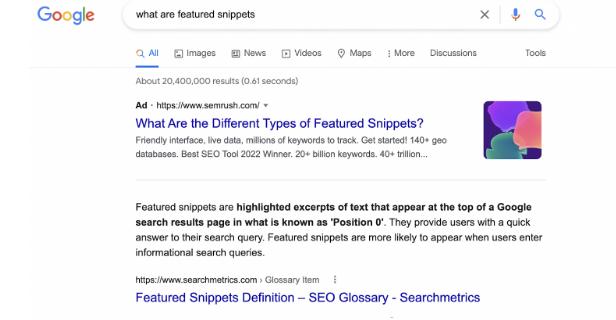
Paragraph featured snippet
Listed featured snippets
About 19% of featured snippets are listed. Lists come in two forms: numbered (with numbers) and bulleted (with dots). They can have six lines (the rest are visible by clicking on the link) or up to 44 words and they are mostly answers to questions that start with “how” or “why.”
Bulleted lists example
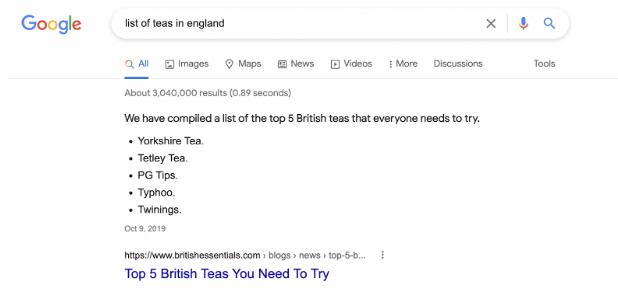
Numbered lists example
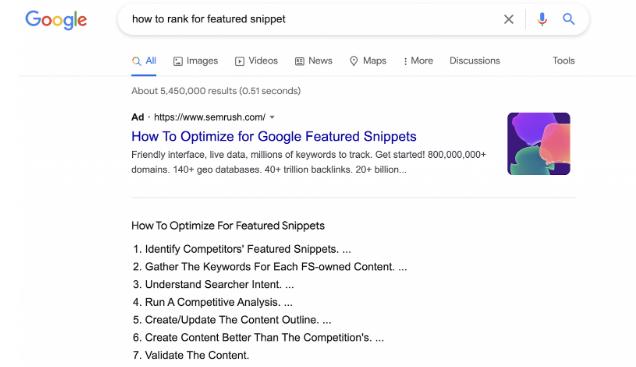
Table featured snippets
Featured snippets in the form of a table make up 6.3% of all snippets. They can contain up to five rows and two columns, with 40 to 45 words. Table featured snippet allows quick and efficient data visualization and comparison.
Table featured snippet example:
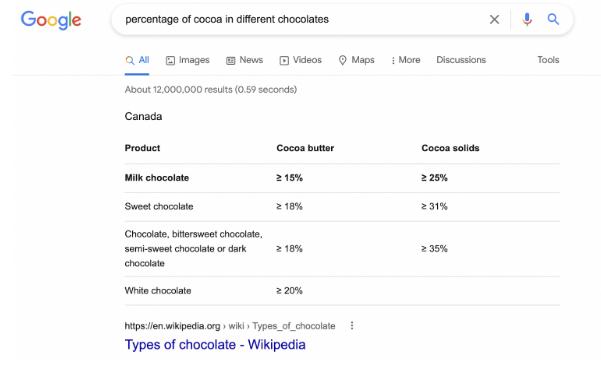
Video featured snippets
Video featured snippets make up 4.6% of all snippets, and the average video duration is 6 minutes and 35 seconds. If the video responds better to the user than the text content, Google will place the video in the featured snippet. Most often, it answers the question “how to.”
Would you be surprised if we told you that all the featured videos are from YouTube? This is to be expected since Google bought YouTube, the largest audio-video search engine, in 2006.
Video featured snippet example:
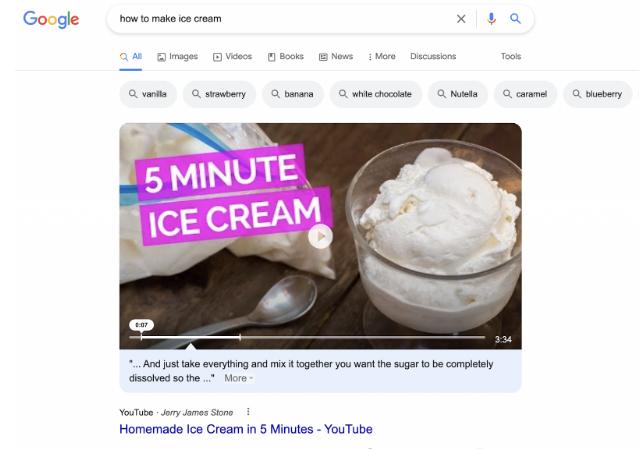
Combined or double-featured snippets
In some cases, Google may combine answers from two sites in a featured snippet if it determines that they are equally important to the searcher’s understanding. The answer can come as a paragraph from one website, while the picture is from another.
Double-featured snippet example:
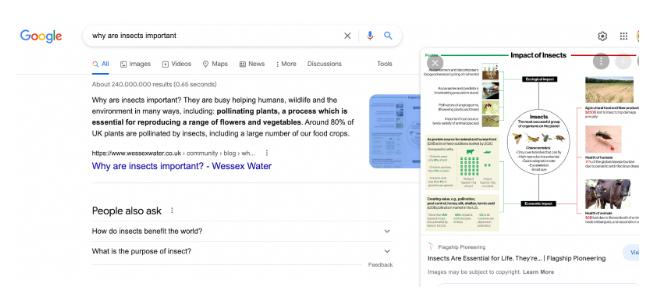
Is every highlighted answer featured snipped?
There is a common misconception that all highlighted answers are actually featured snippets. Sometimes they are rich snippets, images, or Google maps.
For example, suppose you ask a simple question to which the answer is obvious (such as in the picture example). In that case, Google will offer you a rich snippet (highlighted organic search result) that can resemble its slightly more demanding counterpart.
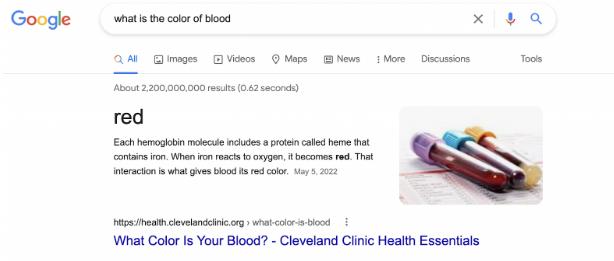
Also, if your query is local the answer will often contain a Google map, which should not be confused with a featured snippet.
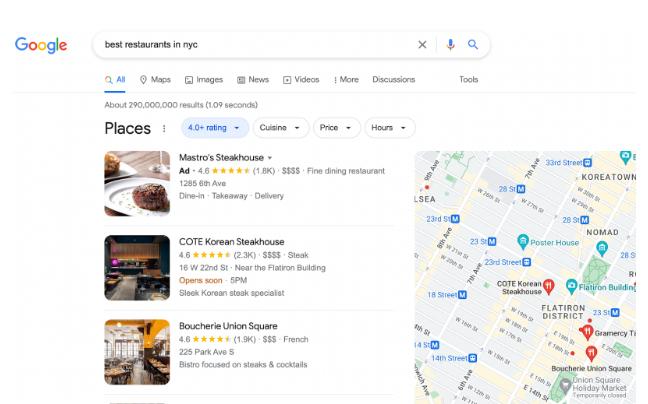
For some queries for which an image is a better answer than text, Google will simply offer you a picture. That image is not a featured snippet, but rather just an answer to your query.
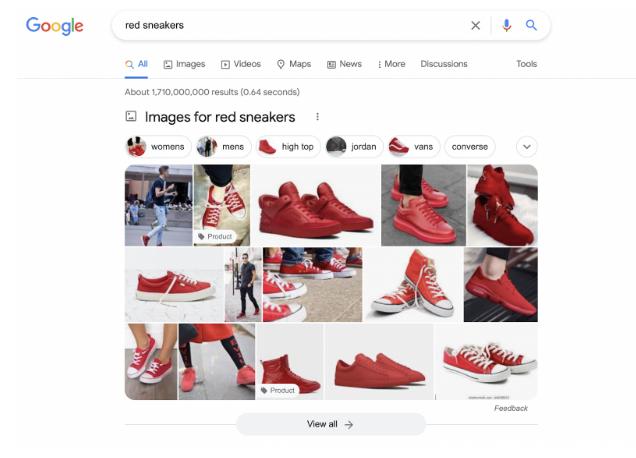
Now that we know what featured snippets are (and what they aren’t), let’s see your chances of getting there and how to optimize for them.
Which categories are most often in featured results?
The niches that most often have featured results on search queries are health, cooking, DIY projects, travel, style and fashion, math, and finance.
Regardless of your niche, you will increase your chances of appearing in the featured results if your content is dominated by comparisons (one vs. another), lists of the best options, recipes, tutorials on how to do something, or concise definitions.
What are your chances of getting featured?
If you rank on the first page of Google search results, your chances of ending up in featured snippets are 70%, according to Getstat. If you are in one of the first ten positions, the chances increase to a dizzying 99.58%, claims Ahrefs. So you don’t have to be in the first position to get a flattering snippet position – just be in the top ten!
The good news: getting featured is often easier than climbing the rankings. If you’re fifth in the SERP, with proper featured snippet optimization, you’ll get to the #0 position faster than on #1.
That brings us to the next important question:
How to optimize for featured snippets?
Since your chances of landing in the featured results increase dramatically if you’re on the first page of search results, all you need to do is improve your content:
- Provide content that is more valuable and that speaks to the user’s search intent more clearly than the competition.
Make sure that your on-page optimization is flawless. - Ask questions and provide concise answers
Since Google provides short answers to questions in the featured results, ensure that your answers are no longer than 42 words, which is the maximum length of a snippet paragraph. After the question in the subtitle, answer briefly in one paragraph, and then elaborate on the answer in the following text if there is a need for it.
Of course, this does not mean your entire content should be short-form. Google loves long articles, but not if they look like an endless wall of text. Divide the article into subheadings for easy scanning (and indexing by Google’s page crawlers).
Try to answer as many related questions as you can find. Let the short-tail keyword that generates the most traffic determine the topic you will cover. A search query can be a headline, while you can find subtitles on “People also ask” or by doing related keyword research on Ahrefs (or other keyword research tools).
Here is an example of what this might look like:
Category (short tail keyword): cinnamon
Title H1 (search query): Is cinnamon healthy?
Subheadings H2:
- Is a teaspoon of cinnamon a day OK?
- What is the best way to take cinnamon?
- Which type of cinnamon is healthiest?
- What is the best time to take cinnamon?
- What does cinnamon do for the body?
Subheadings H3:
- Does cinnamon reduce belly fat?
- Does cinnamon help you sleep?
- Does cinnamon burn fat at night?
- Is cinnamon good for kidneys?
- Is cinnamon good for eyesight?
Structuring your in-depth written article is excellent for visibility in snippets and your SEO.
Google loves numbers and lists
There is always a place for numbers in the featured results: exact amounts of ingredients, weight, unit conversions, step numbers, distance, the time needed to complete a task, and so on.
Ensure you include this information in your content and the introductory paragraph so that Google will recognize it. This will increase your chances of ending up in featured snippets.
Use attractive images for your articles
Featured snippets are even more attractive if accompanied by an image. We don’t know how Google chooses the photos accompanying the featured results. Still, if you do not provide an image, it will be taken from a competing site (as we saw in the double-featured snippet section). Always use eye-catching images for all articles so that each one will be an equally good choice.
Track your progress
Once you’ve created content that answers all of your audience’s potential questions, properly structured it, and enriched it with images, what’s next? Track your site’s progress with the SEO tools you use.
For example, Ahrefs lets you track top pages, organic keywords you’re ranking for (which includes featured snippets), and your competition. If you notice a decrease in traffic, it is a sign that you need to react.
Also, regularly update the content with fresh information so you are always relevant to the given query. Outdated information can never end up in featured results.
Takeaway
Quality content is the basis of good ranking in search engine results, but it can also bring bonuses like featured snippets, which are worth the extra effort.
If you rank in one of the first ten positions of the SERP, your chances of being a featured result increase drastically. As you learn to optimize your content, you’ll come up with several important insights that will positively impact your overall SEO – like how to structure your text, and research the questions your audience is looking for answers to.
Look for the best digital marketing company in Calgary whose experienced specialists know how to drive traffic and boost your search engine ranking, and schedule your consultation today.
To start your way to featured results, identify the keywords for which you are positioned in the top 10 results on Google, and then implement the steps we’ve detailed above. You can also take advantage of others’ professional expertise.
***
Author bio
Melissa Gray is a freelance writer and an organizational psychologist. Her focus is primarily on marketing and new digital trends across the world. In her spare time, she enjoys playing video games with a particular interest in narrative design. She writes for Digital Strategy One.













